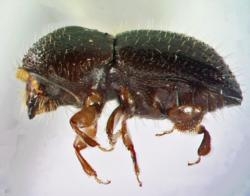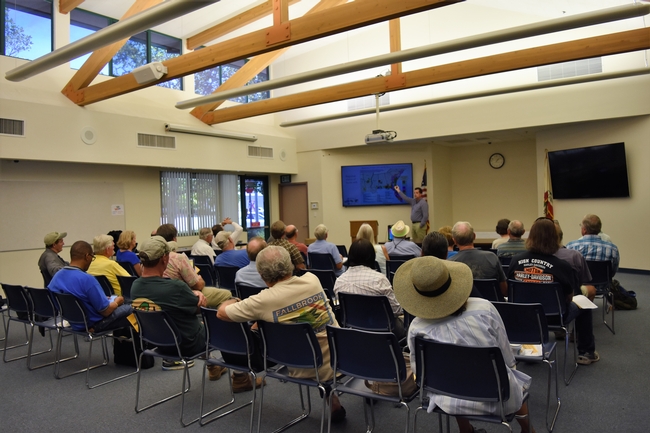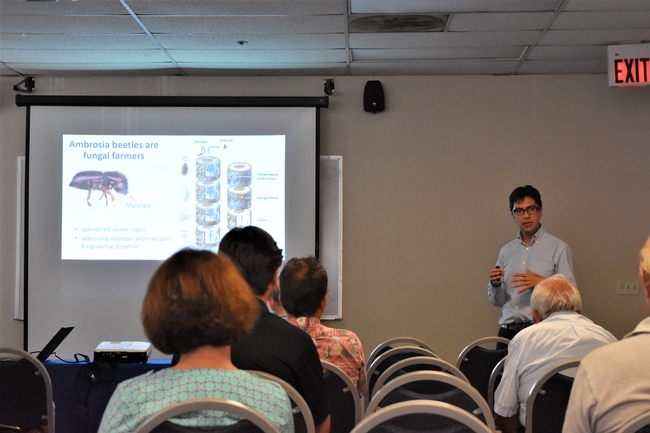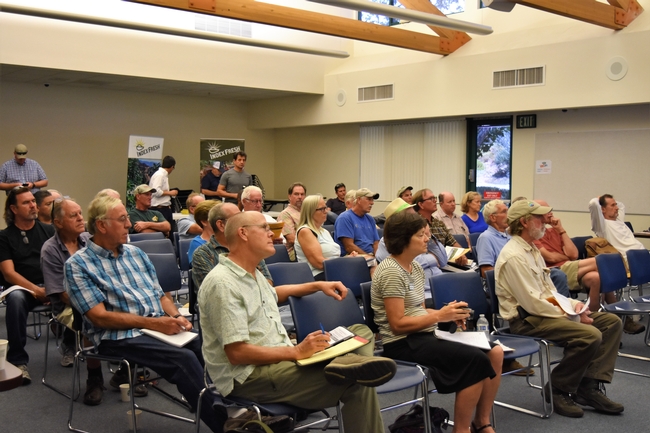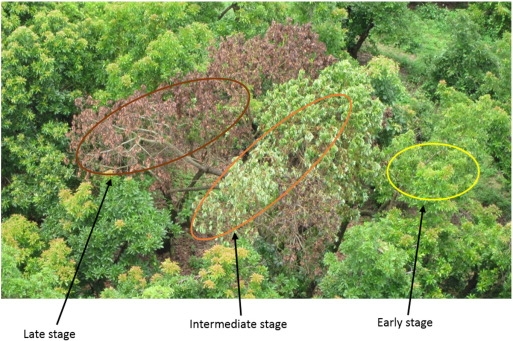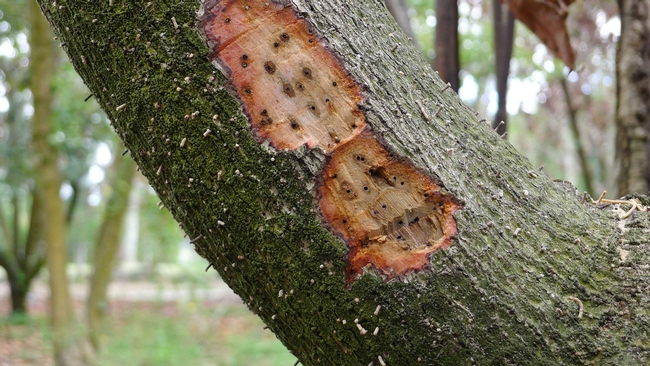- Author: Ben Faber
A recent publication from CA Fish and Wildlife has some wonderful photos of trees that have been known to be attacked by either or both of the Shot Hole Borers, Polyphagous or Kuroshio. The publication can be found at:
The most current listing of hosts and the distribution of the beetles can be found at Akif Eskalen's website:
http://eskalenlab.ucr.edu/distribution.html
Introduction
Shot hole borers (SHB) and Fusarium dieback (FD) represent an increasing threat to many plant species in southern California. Two similar species of invasive shot hole borer exist in southern California, the Polyphagous shot hole borer (PSHB) and the Kuroshio shot hole borer (KSHB) (Euwallacea spp). Shot hole borers are ambrosia beetles forming a symbiotic relationship with the fungi. PSHB symbionts are Fusarium euwallaceae, Graphium euwallaceae, and Paracremonium pembeum, while KSHB forms a symbiotic relationship with two novel species of Fusarium and Graphium (Cooperband et al. 2016) (Lynch et al. 2016) (Eskalen, Stouthamer 2015). These fungi clog the host's vascular tissue leading to branch dieback and eventually tree death. The beetles are not pathogenic in their native habitats in Southeast Asia, preferring instead to infect stressed trees (Hulcr and Dunn 2011). The two shot hole borer species found in southern California differ primarily in the fungal species they associate with but can be treated the same for the sake of management.
SHB infestations begin when females burrow natal galleries into the host, introduce symbiotic fungi, and lay eggs. Females are capable of producing haploid male offspring in the absence of mating while mated females produce diploid female offspring. Eggs mature into adults in six weeks. Beetle emergence occurs over a period of weeks during the spring and summer. Dispersal of females to other hosts is primarily wind-driven, but is also likely facilitated by firewood and green waste movement. Males are incapable of flight; they remain on the host tree but may enter other natal galleries (Umeda, Eskalen, and Paine 2016). Beetle dispersal can occur over large distances if winds allow.
The loss of wildland trees, particularly in riparian areas, poses a threat to numerous threatened and endangered species such as the least Bell's vireo (Vireo bellii pusillus). Destroyed forests give way to invasive species such as giant reed (Arundo donax) and castor bean (Ricinus communis) (Boland 2016). Specifics of this emerging threat are poorly understood and while research is ongoing this guide is intended as an identification aid for land managers in areas where SHB may not yet be discovered.
(references are found at the end of the publication)
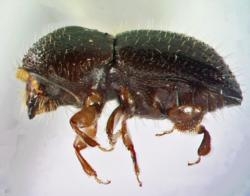
- Author: Sonia Rios
During the first week of August, the California Avocado Society, Inc., California Avocado Commission, University of California Cooperative Extension hosted six Laurel wilt researchers from the University of Florida. The speakers were Randy Ploetz, Jonathan Crane, Bruce Schaffer, Daniel Carrillo, Jeff Wasielewski and Edward Evans. In addition to talking at all three seminar locations, San Luis Obispo, Ventura, and Fallbrook, the researchers were also able to tour the major avocado growing regions.
Laurel wilt is a deadly disease of redbay (Persea borbonia) and other tree species in the Laurel family (Lauraceae), which includes the avocado tree. The disease is caused by a fungus (Raffaelea lauricola) that is introduced into host trees by a nonnative insect, the redbay ambrosia beetle (Xyleborus glabratus). Native to Southeast Asia, the ambrosia beetle has similarities to our current ambrosia pest, Polyphagous shot hole borer and the Kuroshio Borer. That is why this visit from our fellow extension researchers from the University of Florida. However the fungus associated with Laurel Wilt is unlike the disease here in California. Laurel Wilt is a disease that that causes a reaction in the tree to restrict water flow in the tree and the tree collapses rapidly. The tree dies so fast that it doesn't even have a chance for the leaves to fall of the dead branches.
The beetle has the ability to spread the specific pathogen to other ambrosia beetle vectors which happens when they feed on infected trees. Sanitation is the most effect way to manage this problem. Scouting for wilted branches and their rapid removal has been the key to early intervention and eradication. Dr. Ploetz suggests removing the tree immediately. By the time you see frass and streaks in the wood, the tree is already infected and has been for sometime. As soon as a growers see the wilt in the branches, its time to move quickly. This disease may be mistaken for Verticillium wilt or Phytophthora. It can spread throughout the grove by root grafting.
The generation time for the beetle inside avocado trees takes about 40-50 days depending upon temperatures. Their flight activity is highest in the late afternoon and early evening. Dr. Carrillo mentioned that ambrosia beetles are notoriously difficult to control because they are inside the tree most of their life cycle versus being outside the tree. Contact herbicides will not work, because the insects are primarily inside the tree. One of the first goals to avoid infection, is to keep your trees healthy. A sick tree is more attractive 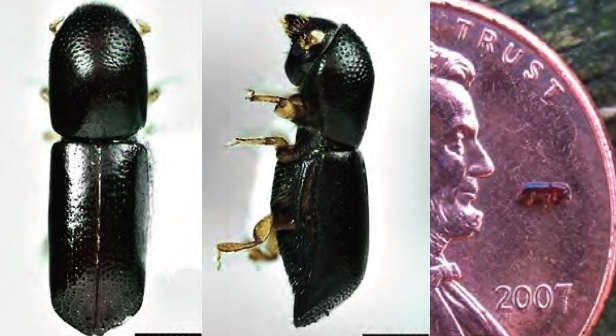
Scouting for laurel wilt in commercial avocado groves
1. Surveying for the symptoms of laurel wilt is a key component of limiting the spread of laurel wilt. Growers and their workers should survey their groves immediately and then weekly or more often if an infestation is detected in an adjacent grove. Pathogen sniffing dogs are currently being used, however there are less than half-dozen trained dogs for this purpose. Symptoms to look for might include:
i. Leaf and young stem wilting.
ii. Leaf color changing from light green to dark green, bluish-green or greenish-brown. Some leaves showing leaf mottling (dark and light green areas) and yellowing.
iii. Dead leaves curled hanging on the tree.
iv. A few stems and limbs with 2 to 4 ft of dieback or whole sections or entire limbs with dieback.
v. Inspection of the trunk and major limbs may show dried sap (white, crystalline powdery material) that indicates insect boring. In any case, on symptomatic limbs remove the bark down to the sapwood and look for dark streaking. Dark streaks in the sapwood may indicate fungal infection. Normally this sapwood should be white to yellowish with no dark staining or streaking. In addition, small, dark holes in the sapwood further indicate wood boring beetles are present.
2. If the tree shows only a few stems and limbs with 2 to 4 ft of dieback, wait for confirmation of laurel wilt before removing the tree. You can remove the dead part of the limb by cutting several feet below the dead area of the limb; burn or bury the infested limb.
- Author: Ben Faber
Many growers don't hear about the amount of research and extension activity that is going on surrounding the Shot Hole Borers and Fusarium Dieback. This pest/disease complex affects not only avocados, but many other tree species, including many California natives. These are the notes from a Collaborative organized by UC ANR. There is a lot of energy by a lot of groups addressing this massive problem.
Invasive Shot Hole Borer (Polyphagous and Kuroshio)/Fusarium Dieback
Quarterly Situation Report
January 1 through March 31, 2017
Executive Summary
Overview
No spread of invasive shot hole borer/Fusarium dieback (ISHB/FD) was reported this quarter, which may have been due to cool seasonal temperatures and resulting insect inactivity. The period served to establish new trapping sites, evaluate programs, and establish new ones.
Trapping locations expanded in Orange, Ventura, and Santa Barbara Counties. A new trapping program was started that serves the Santa Monica Mountains, Conejo and San Fernando Valleys.
An urban observational project modeled after successes in Orange County was initiated in Ventura County. The project can potentially expand monitoring by citizen scientists throughout the region to benefit tracking and treatment.
Representatives of various public, academic, and private entities from seven of the nine southern California counties participated in activities, which are summarized below
Statewide
o ISHB/FD dialogue continued between counties, Agricultural Commissioners, and other stakeholders through conferencing hosted by the California Agricultural Commissioners and Sealers Association. Education and outreach to counties without infestations is tantamount for detection and readiness
o Outreach was initiated to Inyo and Mono Counties in eastern California
o Legislative outreach and education continued to State Assembly and California Department of Food and Agriculture
o California Department of Fish and Wildlife hired staff for ISHB monitoring, trapping, developing a wildlands field guide, and creating a management matrix
o Media interviews about ISHB/FD were conducted for publications, many of which are circulated online.
Regional
o Two ISHB/FD working groups met:
- Emerging Tree Pests Education& Outreach Subcommittee (5x)
- Natural Resources/Urban Forest SHB Coalition (3x)
o University of California (UC) researchers continued investigations with bio-control agents and pesticides to combat ISHB/FD
o A UC publication focused on ISHB/FD invasion to palm trees was published
San Diego County
o The Resource Conservation District of San Diego researched funding to continue ISHB/FD monitoring, trapping, education, and outreach needs
o Southwest Wetlands Interpretive Association continued studying the SHB infestation and found that an estimated 88% of plant material in the Tijuana River Valley was affected despite recovery following massive SHB-caused dieback in 2016
o UC-ANR & the Emerging Tree Pests Education and Outreach Subcommittee organized and presented the Southern California Green Waste and Wood Biomass Symposium held in San Diego
Riverside County
o California Association of Certified Pest Control Advisors and University of California Agriculture and Natural Resources Division (UC-ANR) presented a half-day ISHB/FD workshop in Temecula
o ISHB/FD training for State Parks rangers from the Inland Empire District was held in La Quinta
Orange County
o California Department of Fish & Wildlife added new trapping and monitoring sites that included nature preserves, large institutional campuses, and parkways
o California State Parks trapped at Crystal Cove, with no positive finds
o ISHB/FD training was conducted for US Fish & Wildlife Service staff
o Monitoring protocols for oak and sycamore were developed for the 4000-acre Audubon Starr Ranch in Trabuco Canyon
o Orange County Master Gardeners received ISHB/FD training
o Orange County Parks expanded trapping and monitoring activities to more parks, with Irvine Regional Park a focal point
o Outreach continued throughout the county, with added focus to the business community
Los Angeles County
o The Huntington continued monitoring its 207-acre parcel
o The Resource Conservation District of the Santa Monica Mountains (RCDSMM) initiated trapping in the Santa Monica Mountains with partner National Park Service (NPS) – Santa Monica Mountains National Recreation Area
o RCDSMM conducted trap making and trapping workshops for trapping in the San Fernando Valley and Santa Monica Mountains
o UC-ANR met with City of Downey staff to discuss current infestations and monitorin
Ventura County
o California Association of Certified Pest Control Advisors and University of California Agriculture and Natural Resources Division (UC-ANR) presented a half-day ISHB/FD workshop in Ventura
o Master Gardener urban observation project began
o RCDSMM and NPS established trapping sites in the Santa Monica Mountains/Conejo Valley area
o UC Santa Barbara and UC-ANR coordinated an all-day meeting of the Santa Clara River Academic Coalition to discuss research being conducted in the watershed
o Ventura County Agricultural Commissioner continued monitoring traps at avocado orchards in the Santa Paula area
o UCSB continued trapping in riparian areas in the Santa Clara River watershed and started establishing sites in the Ventura River corridor
Santa Barbara County
o Santa Barbara County SHB Working Group met (1x)
o UC-ANR education and outreach was delivered by print and online media, tabling, and public events
o UC-ANR met with Montecito Fire Department and the Santa Barbara County Fire Safe Council to discuss ISHB/FD threat
o UCSB/UCR continued monitoring traps in the Montecito area and established new sites in the City of Santa Barbara foothills
San Luis Obispo County
o CAL FIRE explored funding for trapping, monitoring, education and outreach
PSHB Working Group Coordination
Active groups – regionwide
o There are currently nine working groups focused on shot hole borers. PSHB/KSHB updates and discussions on research, education and outreach strategies took place during group coordination meetings held, in person and via conference calls:
- CACASA – California Agricultural Commissioners and Sealers Association (J. Deviney, Agricultural Commissioner-Santa Clara County group conference call facilitator - 3/22)
- Emerging Tree Pests Education and Outreach Committee (A. Cornejo, US Fish & Wildlife Service, facilitator – 1/25, 2/8, 2/22, 3/8, 3/22)
- Natural Resource / Urban Forestry Shot Hole Borer Coalition (Chaired by California Department of Fish and Wildlife – G. Sevrens, facilitator – 1/3, 2/7, 3/7)
- Orange County Emerging Tree Pests Group
- San Diego Association of Governments – Emerging Tree Pests Subcommittee (SANDAG)
- Santa Barbara County Shot Hole Borer Working Group (M. Bianchi, University of California Cooperative Extension – Santa Barbara & San Luis Obispo Counties – group facilitator, 3/23)
- University of California Emerging Tree Pests Working Group – statewide for ISHB – (S. Drill, University of California Cooperative Extension – Los Angeles & Ventura Counties – group facilitator, 3/9)
- Ventura County Green Waste and Pest Prevention Advisory Committee
- Ventura County Polyphagous Shot Hole Borer Working Group (S. Drill, University of California Cooperative Extension – Ventura – group facilitator)
John Boland, Southwest Wetlands Interpretive Association (SWIA) – Imperial Beach
o Continued studying KSHB in the Tijuana River Valley riparian forest, with funding from the US Navy and US Fish & Wildlife Service
Sabrina Drill, UC Cooperative Extension – Ventura & Los Angeles Counties
o Met with Santa Clara River Academic Coalition to discuss SHB research, monitoring, trapping efforts in the watershed – (3/1)
o Coordinated Cooperative Extension/UC Riverside SHB coordination working group meeting in Riverside – (3/9)
o Participated in California Agricultural Commissioners & Sealers Association (CACASA) statewide call – (3/22)
Tom Dudley, UC Santa Barbara – Marine Science Institute
o Coordinated Santa Clara River Academic Coalition meeting for the watershed – (3/1)
Jan Gonzales, UC Cooperative Extension – San Diego
o Participated in Coordinating Work Group Meetings/Calls:
- Natural Resources/Urban Forestry SHB Coalition (1/3, 2/7, 3/7)
- Emerging Tree Pests Education and Outreach Committee (1/25, 1/11, 3/8, 3/22)
- Statewide PSHB Group (3/22)
o Coordinated visit to the San Diego Zoo and gave briefing on ISHB during field tour for UC ANR's Associate Vice President, Wendy Powers; Chris Greer, Vice Provost of Cooperative Extension and guests from the National eXtension program (1/24)
Funding, Legislation, Planning, Policy and Regulation
John Kabashima, UC Cooperative Extension – Orange County
o Gave a team talk with the California Department of Food and Agriculture (CDFA) Director of Plant Health to the Invasive Species Council of California (ISCC) on PSHB/KSHB/FD as an example of emerging tree pests that the present system isn't addressing effectively. Ideas to address this by CDFA and the ISCC Advisory committee are incorporated in their interagency "Charting the Pest Prevention System in California" plan. The California Assembly Speaker's office suggested we identify an Assembly Democrat who would ask the State agencies to address this issue and recommend a plan and budget. This would be determined through either a special summit meeting or Assembly hearing. Several approachable Assemblymembers were identified to collaborate on this matter (1/5)
o Discussed SHB funding needs with collaborators, including the Resource Conservation District of San Diego County, University of California Cooperative Extension San Luis Obispo
Surveying/Monitoring/Detection/Mapping
Dan Berry & Tim Thibault, The Huntington Gardens – Pasadena
o Continued plant collection monitoring for 207 acres
Rosi Dagit, Resource Conservation District (RCD) of the Santa Monica Mountains – Topanga
- Conducted Santa Monica Mountains SHB trapping coordination meeting with the RCD and Santa Monica Mountains National Recreation Area staff (1/24)
- Taught a SHB trap making and monitoring workshop at Malibu Creek State Park for– (3/1
- Sandy De Simone, California Audubon – Trabuco Canyon
o Met with Audubon Starr Ranch seasonal riparian assistants in January to devise a protocol for monitoring oaks and sycamores for pests and disease on the 4,000 acre property located in southeast Orange County
Sabrina Drill, UC Cooperative Extension, Ventura and Los Angeles Counties
o Met with UCCE Ventura Master Gardener Program Coordinator Leah Hanson to discuss upcoming SHB observational training and urban monitoring sites throughout the county as part of the new Tree Detective program in sycamores – 3/27/17
John Kabashima, UC Cooperative Extension - Orange County
o Discussed SHB infestations and monitoring with City of Downey officials (1/18)
Lana Nguyen, State Parks – Orange Coast District
o Received confirmation from the Eskalen Lab that tree specimen from Crystal Cove was negative for Fusarium dieback
Cathy Nowak, Orange County Parks – Irvine
o UCCE completed surveys & mapping for Aliso & Wood Canyons Wilderness Park, Key Ranch, Heritage Hill, and O'Neill Regional Park to Oso Parkway
o Monitoring continues at Irvine Regional Park
o Twelve monitoring stations were established at Whiting Ranch Wilderness Park – Trabuco Canyon
Gail Sevrens, California Department of Fish & Wildlife, South Coast Region – San Diego
o Hired two new Scientific Aides, Ryan Lawler and Aidan Renner. They are assembling an expanded field guide to identifying SHB in wildland settings as well as a management matrix to determine the best course of action in the event that it is found. Theywill begin monitoring and trapping for SHB in the region
o Worked with the SHB Survey Committee, to investigate what kind of and how frequently surveys are being done
Research Activities and Findings
Dan Berry and Tim Thibault, The Huntington – Pasadena
o Traveled with Akif Eskalen and Richard Stouthamer to Taiwan for the purpose of PSHB bio-control and insect agents (January)
o Finalized stress test with Colin Umeda (UC Riverside)
John Boland, Southwest Wetlands Interpretive Association (SWIA) – Imperial Beach
o The Tijuana River Valley is the first natural habitat to be substantially invaded by the KSHB. It first appeared in the valley in 2015 and almost immediately caused extensive damage to the riparian forests. It is estimated a total of 355,510 willows, or 88% of the population in the valley, have already been infested. More than two billion (2 x 109) beetles were born in the valley during 2015-16. This was likely the single largest production of offspring by this beetle in the US so far.
o KSHB has not killed all of the willow trees it infested. Many heavily damaged by the KSHB during 2015 re-sprouted in 2016. In some sites, where the willow canopy was destroyed by the KSHB, there is now an extensive short canopy of re-sprouting willow “shrubs” up to four meters tall.
o A final report on this research will be released in April 2017
Tom Dudley, University of California Santa Barbara – Marine Institute
o Interfaced with Institute staff and graduate researchers to monitor, trap, and research SHB in Santa Barbara and Ventura Counties
o Attended an interagency invasive species meeting in January on the east coast, noting several talks and posters on SHB. There is a continued research effort on semiochemicals, which UCSB may be involved at the research testing level
Akif Eskalen, UC Cooperative Extension – Riverside County
o Traveled with Richard Stouthamer (UC Riverside), Dan Berry and Terry Thibault (both from The Huntington) to Taiwan for the purpose of PSHB bio-control and insect agents (January)
Nathan Gregory, Irvine Ranch Conservancy – Irvine
o The Irvine Ranch Conservancy surveyed lower Agua Chinon at Limestone Canyon Nature Preserve in Silverado (northern Orange County foothills) and found no signs of PSHB. However, 12 potentially infested trees were identified in Bommer Canyon Community Park, Irvine (near Turtle Ridge) with samples taken and submitted to the Eskalen Laboratory at UC Riverside. Of those 12, five were surveyed last year and found to be newly infested this year. The other seven are newly surveyed this year.
Cathy Nowak, Orange County Parks – Irvine
o Tim Paine continued pesticide treatments at Mason Regional Park - Irvine that examine five treatments on ten trees. Focus is on compounds that have shown promise in previous trials at UC Irvine and in the laboratory
o Akif Eskalen's final report on the pesticide trials conducted at three regional parks is forthcoming
Richard Stouthamer, UC Riverside
o Traveled with Akif Eskalen (UCCE-Riverside), Dan Berry and Terry Thibault (both from The Huntington) to Taiwan for the purpose of PSHB bio-control and insect agents (January)
Management and Restoration
Dan Berry and Tim Thibault, The Huntington – Pasadena
o Removed and replaced two PSHB-infested Quercus robur (English oak)
Gail Sevrens, California Department of Fish and Wildlife (CDFW), South Coast Region – San Diego
o Inquired about trunk injection of pesticides on creek banks and in dry creek beds. CDFW pesticide unit was consulted. Learned that applications consistent with label instructions are alright to use, as long as trees are not growing in the water. Can be okay if next to water. Said ecological risk outweighs risk of insects.
o Updating and gathering input on Southern California Shot Hole Borers/Fusarium Dieback Management Strategy for Natural and Urban Landscapes
Wood Utilization, Sanitization, and Disposal
Dan Berry and Tim Thibault, The Huntington – Pasadena
o Continued PSHB-infested green waste grinding and material redistribution
Education and Outreach/Media Coverage
Dan Berry and Tim Thibault, The Huntington – Pasadena
o Gave PSHB presentation to 20 physicians at the Huntington Medical Research Institute
o Engaged with Earthwatch during an extended meeting about a citizen science initiative
Mary Bianchi, UC Cooperative Extension – Santa Barbara & San Luis Obispo Counties
o Began education and outreach in the greater Santa Barbara area following first population of KSHB located in Montecito. Wrote and published two online articles:
- http://www.news.ucsb.edu/2017/017516/holy-guacamole
- https://www.edhat.com/site/tidbit.cfm?nid=179674
o Met with Kerry Kellogg from Montecito Fire and some of their staff, along with UC statewide Fire Specialist Max Moritz (1/17)
o Articles will be published in the Montecito Journal, newsletters of the Montecito Association, Ennisbrook Homeowner's Association, and Westmont College
o Gave a presentation at the Santa Barbara Fire Safe Council Meeting (2/16)
o Outreach and tabling were conducted at the Montecito Farmer's Market and Lotusland in Montecito
California Association of Pest Control Advisers (CAPCA) – Sacramento
o Hosted two half-day SHB educational events for agricultural and general audiences:
- January 25 in Ventura
- January 26 in Temecula
- Speakers included UC entomology experts Richard Stouthamer, Akif Eskalen, Frank Byrne, Tim Paine, and John Kabashima
Julie Clark De Blasio, UC Cooperative Extension – Ventura
o Participated
in bottle-trap making workshop at Malibu Creek State Park (3/18). Traps will be set in wildland-urban interface areas of Brentwood in the Santa Monica Mountains
Rosi Dagit, Resource Conservation District (RCD) of the Santa Monica Mountains – Topanga
o Coordinated a half-day SHB bottle-trap making workshop at Malibu Creek State Park (3/18). The 15 participants will support trapping efforts in the Santa Monica Mountains and San Fernando Valley
Sabrina Drill, UC Cooperative Extension – Ventura & Los Angeles Counties
o Gave interview for California Agricultural Pest Control Advisers (CAPCA) video series on SHB (1/25)
o Gave interview for ‘Central Coast Farm and Ranch'(2/3):
- Bug at Bay story published Spring 2017, V14N3, pp6-8
Tom Dudley, University of California Santa Barbara – Marine Science Institute
o Coordinated the Santa Clara River (SCR) Academic Collaboration meeting held at Hansen Agricultural Research and Extension Center, Santa Paula (3/1). UCSB is establishing numerous SHB trapping sites in wildland watersheds throughout Ventura County, with a focus on areas near infestations in the SCR
Akif Eskalen, UC Cooperative Extension – Riverside County
o Gave ISHB presentation at two half-day educational events for agricultural and general audiences sponsored by California Agricultural Pest Control Advisors:
- January 25 in Ventura
- January 26 in Temecula
- Jan Gonzales, UC Cooperative Extension - San Diego County
o The Southern California Green Waste-Wood Biomass Symposium was held February 9 at the Handlery Hotel in San Diego. Members of the Emerging Tree Pests Education and Outreach Committee coordinated the day-long event. It was intended to engage multiple industry and practitioner stakeholders from public and private sectors, along with researchers and policy makers. Discussions on how to best address larger regional issues related to managing residual materials of invasive pest infested and dead trees were the focus. For more information, including presentation slides see http://ucanr.edu/sites/SoCA_GWWood__Mgmt_Symposium. 108 individuals attended, with a 54% evaluation survey response rate.
- 94.8% reported their awareness about the scope, continued threat and challenges to managing surplus green waste-wood biomass increased by a moderate to great extent
- 87.9% responded they learned more about management options and strategies for green waste-wood residuals by a moderate to great extent
- 84.5% replied they are very likely to share with others what they learned at this symposium
o Park Rangers Association of California Training and Conference
Co-presented with Gina Moran (CA State Parks) on Invasive Tree Pests including ISHB/FD, gold-spotted oak borer and South American palm weevil, February 28, 2017, La Quinta, CA.
o Distributed ISHB and related handout materials:
- 200 SHB general audience handouts
- 50 SHB ID and Symptoms handouts
- 50 SHB Management handouts
- 25 SHB ID Field Guides
- 750 Buy It Where You Burn It firewood awareness rack cards
This report is a summary of known activity relating to Polyphagous and Kuroshio Shot Hole Borer/Fusarium Dieback for the stated 3-month period. If there are any additions, corrections or comments, send them to Sabrina Drill, sldrill@ucanr.edu and/or post information to the PSHB Working Group Collaborative Tools group. Report compiled by Jan Gonzales, UCCE-San Diego
PSHB Working Group Stakeholder Organizations
APHIS (USDA Animal and Plant Health Inspection Services)
California Agricultural Commissioners and Sealers Association (CACASA)
California Audubon, Starr Ranch
California Avocado Commission CAL FIRE (California Department of Forestry and Fire Protection) California Department of Fish and Wildlife California Department of Food and Agriculture California Firewood Taskforce California Native Plant Society California Department of Parks and Recreation California State Senate Center for Invasive Species Prevention Center for Natural Lands Management City of Pasadena City of San Diego Davey Tree Service Everest Consultants Farm Bureau-San Diego County Farm Bureau-Ventura County Los Angeles County Agriculture, Weights and Measures Los Angeles County Arboretum Los Angeles County Fire and Forestry Los Angeles County Parks National Park Service Native American Environmental Protection Coalition Nature Reserve of Orange County North East Trees NRCS (USDA Natural Resource Conservation Service) Orange County Agricultural CommissionerOrange County Fire Authority Orange County Parks Orange County Public Works Rebecca Latta Consulting ArborisResource Conservation District of San Diego Resource Conservation District of the Santa Monica Mountains River Partners San Diego County Agriculture, Weights and MeasuresSan Diego County Parks SANDAG (San Diego Association of Governments) Santa Barbara County Agriculture DepartmentSanta Barbara County Master Gardeners Santa Clara County Agricultural Commissioner/CACASA Pest Prevention Committee Southwest Wetlands Interpretive Association (SWIA) Sycuan Band of the Kumeyaay Nation The Huntington Library, Art Collections and Botanical Gardens The Nature Conservancy Tree People University of California Cooperative Extension University of California Division of Agriculture and Natural Resources (UCANR)
University of California, Irvine
University of California, Riverside
University of California, Santa Barbara
University of California, Santa Cruz
USDA Forest Service USDA Forest Service-Cleveland NF USDA Forest Service-Forest Health Protection USDA Forest Service-State and Private Forestry, Region 5
USDI Bureau of Indian Affairs
USDI Bureau of Land Management
USDI Fish and Wildlife Service
USDI National Park Service-Santa Monica Mountains National Recreation Area
Valley Crest Tree Company
Ventura County Agricultural Commissioner West Coast Arborists, Inc. Western Chapter of International Society of Aboriculture
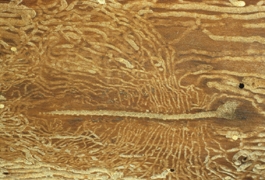
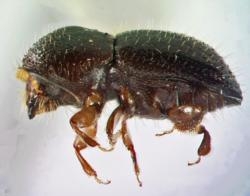
- Author: Frank Byrne, Akif Eskalen and Joe Morse
Two closely related Ambrosia beetles (Euwallacea sp.) have been identified in commercial avocado groves in California. The polyphagous shot hole borer (PSHB), detected in Los Angeles, Orange counties and recently in Ventura county, and the Kuroshio shot hole borer (KSHB), detected in San Diego and recently in Orange and Santa Barbara counties, are morphologically indistinguishable, but genetically distinct. Already widespread in a variety of reproductive host trees common in the urban landscape (including box elder, willow, several maples, oak and sycamore species), the beetles represent a significant threat to trees in both landscape and agricultural settings. Adult females construct galleries in the xylem system of host trees, where they cultivate symbiotic fungi (Fusarium, Paracremonium and Graphium spp.) as a food source for their developing young. The fungi are taken up by progeny females in specialized organs within their mouthparts, and transported to other sites within the same tree, where new colonies are established, or to newly colonized hosts. The galleries compromise the structural integrity of infested trees, which can represent a serious safety hazard in urban environments, and disrupt the flow of water and essential nutrients within the xylem. In addition to the physical damage, the fungi extract nutrients from the xylem system, further depriving the tree of nutrients essential for healthy growth and fruit production.
An effective biological control agent is not yet available to manage the SHB in California, and so management for now must rely on the use of chemical pesticides. The control of Ambrosia beetles and their associated fungi using
chemical pesticides is complicated because of their location inside the host trees. The application of insecticides to the external surfaces of trees, where the beetles must first alight prior to boring, has the potential to kill beetles by contact activity, and they may also have the potential to control emerging young adults before they can re-infest the trees.
The drawback of surface treatments is that multiple applications are often required because of the relatively short duration of efficacy. In addition, once the beetle burrows inside the tree, surface treatments are become ineffective. One possible solution to this problem may be the use of systemic pesticides, and scientists at UC Riverside are evaluating the use of both systemic insecticides and fungicides in a 2-pronged attack against the symbiotic system.
Systemic pesticides are mobile within the xylem system of plants, and the fungicides could potentially target the fungi growing in the xylem and deprive the beetle larvae of a food source. The insecticides would prevent the beetle from establishing galleries within susceptible tree hosts, and prevent the survival of beetles and their offspring already present within trees. The big problem with systemic pesticides is getting sufficient concentrations of chemicals to the areas within the trees where the beetle and fungus occur. Although there are exceptions, most systemic treatments are administered to the soil for uptake through the roots. However, in mature avocado groves, the high organic matter content of the soil can prevent effective absorption by roots because the pesticide becomes bound to organic components within the soil. Trunk injection of pesticides directly into the vascular system of trees eliminates the potential for binding of pesticides within the soil, and increases the amount of active ingredient inside the tree available to impact the beetle/fungal system. Systemic pesticides must be formulated for trunk injection and so careful evaluation is needed to ensure optimal efficacy. Trials are being conducted with the assistance of avocado industry and grower collaborators in areas where the SHB has been recorded. The chemicals are injected into the trees using commercially available equipment, and the movement of the active ingredients is then monitored over time in wood core samples taken at different heights of the trees. Two methods are being used to confirm the presence of the chemicals. Insecticides are being quantified using ELISAs that are specific for the active ingredients under investigation. Wood cores taken from trees treated with fungicides are placed in direct proximity to the fungal pathogens growing on agar plates to determine if growth of the fungus is inhibited.
The investigations are still at an early stage, but the researchers are optimistic that they will develop effective control strategies for the SHB that growers can incorporate into their overall pest management programs. Laboratory based bioassays have been used to identify several pesticides that are toxic to the beetle and fungi. The objective of the field trials is to determine whether these chemicals can be utilized as trunk injection agents for the protection of avocado trees. Anyone interested in finding out more about the SHB should go to the web site maintained by Dr. Akif Eskalen at:
http://eskalenlab.ucr.edu/avocado.html
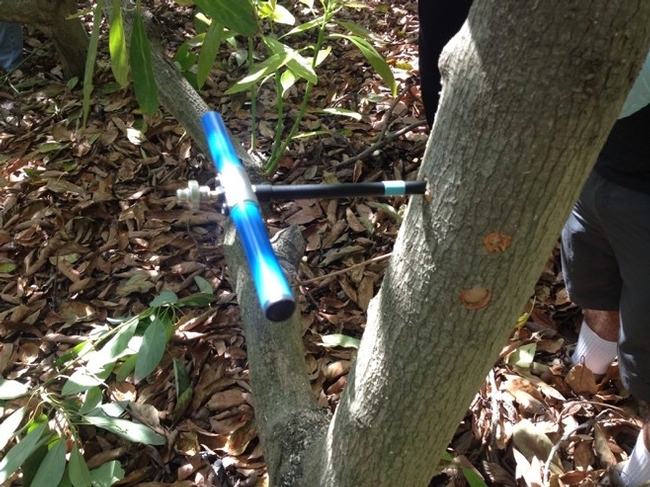
- Author: Ben Faber
At a recent conference in Florida, University of Florida entomologist Daniel Carrillo reported some very disturbing news. There is a fungus/pest complex in Florida avocado and related native laurel species that is similar to a complex found in the California - Shot Hole Borer/Fusarium fungus complex. There it is called Laurel Wilt Disease and is a complex of the ambrosia beetle Xyleborus and the fungus Rafaelea lauricola. It is a fungus/insect complex that causes death in avocado and the relatives of avocado trees. The California complex can cause the death of many tree species, such as sycamore, coast live oak and willow, as well as the decline of avocado. The complex and disease are called Fusarium Dieback here, caused by Euwallacea ambrosia beetle and Fusarium fungus.
What Carrillo and other colleagues have found is that there are similar species to their introduced Rafaelea species of ambrosia beetle that are now attacking live avocado trees. These so-called cryptic species are members of a group of beetles that normally do not attack live trees. These beetles are typically some of the first group of decomposers that go after dead trees. These newly identified insects are morphologically very similar to the original beetle, but are native members of the Florida environment. They too are now attacking live trees. There are now ten potential species of ambrosia beetle that can introduce pathogenic fungi.
To exacerbate the situation, there are other fungi now that have been associated with these beetles that may be similarly as pathogenic as the original fungus. These fungi are genetically distinct from the species causing damage in California. However, this ability of different fungi to adapt to a new invasive beetle species and the ability of other beetle species to pick up the pathogenic fungal species is a scenario that might appear in California.
As the world becomes smaller and more living materials are moved around and they mix, this may be the new reality we are facing.
To read more about the Florida findings check out the article:
http://www.mdpi.com/2075-4450/7/4/55
http://ucanr.edu/sites/socaloakpests/Polyphagous_Shot_Hole_Borer/
